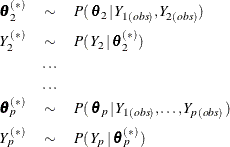The MI Procedure
- Overview
- Getting Started
-
Syntax

-
Details
 Descriptive StatisticsEM Algorithm for Data with Missing ValuesStatistical Assumptions for Multiple ImputationMissing Data PatternsImputation MethodsMonotone Methods for Data Sets with Monotone Missing PatternsMonotone and FCS Regression MethodsMonotone and FCS Predictive Mean Matching MethodsMonotone and FCS Discriminant Function MethodsMonotone and FCS Logistic Regression MethodsMonotone Propensity Score MethodFCS Methods for Data Sets with Arbitrary Missing PatternsChecking Convergence in FCS MethodsMCMC Method for Arbitrary Missing Multivariate Normal DataProducing Monotone Missingness with the MCMC MethodMCMC Method SpecificationsChecking Convergence in MCMCInput Data SetsOutput Data SetsCombining Inferences from Multiply Imputed Data SetsMultiple Imputation EfficiencyNumber of ImputationsImputer’s Model Versus Analyst’s ModelParameter Simulation versus Multiple ImputationSensitivity Analysis for the MAR AssumptionMultiple Imputation with Pattern-Mixture ModelsSpecifying Sets of Observations for Imputation in Pattern-Mixture ModelsAdjusting Imputed Values in Pattern-Mixture ModelsSummary of Issues in Multiple ImputationPlot Options Superseded by ODS GraphicsODS Table NamesODS Graphics
Descriptive StatisticsEM Algorithm for Data with Missing ValuesStatistical Assumptions for Multiple ImputationMissing Data PatternsImputation MethodsMonotone Methods for Data Sets with Monotone Missing PatternsMonotone and FCS Regression MethodsMonotone and FCS Predictive Mean Matching MethodsMonotone and FCS Discriminant Function MethodsMonotone and FCS Logistic Regression MethodsMonotone Propensity Score MethodFCS Methods for Data Sets with Arbitrary Missing PatternsChecking Convergence in FCS MethodsMCMC Method for Arbitrary Missing Multivariate Normal DataProducing Monotone Missingness with the MCMC MethodMCMC Method SpecificationsChecking Convergence in MCMCInput Data SetsOutput Data SetsCombining Inferences from Multiply Imputed Data SetsMultiple Imputation EfficiencyNumber of ImputationsImputer’s Model Versus Analyst’s ModelParameter Simulation versus Multiple ImputationSensitivity Analysis for the MAR AssumptionMultiple Imputation with Pattern-Mixture ModelsSpecifying Sets of Observations for Imputation in Pattern-Mixture ModelsAdjusting Imputed Values in Pattern-Mixture ModelsSummary of Issues in Multiple ImputationPlot Options Superseded by ODS GraphicsODS Table NamesODS Graphics -
Examples
 EM Algorithm for MLEMonotone Propensity Score MethodMonotone Regression MethodMonotone Logistic Regression Method for CLASS VariablesMonotone Discriminant Function Method for CLASS VariablesFCS Methods for Continuous VariablesFCS Method for CLASS VariablesFCS Method with Trace PlotMCMC MethodProducing Monotone Missingness with MCMCChecking Convergence in MCMCSaving and Using Parameters for MCMCTransforming to NormalityMultistage ImputationCreating Control-Based Pattern Imputation in Sensitivity AnalysisAdjusting Imputed Continuous Values in Sensitivity AnalysisAdjusting Imputed Classification Levels in Sensitivity AnalysisAdjusting Imputed Values with Parameters in a Data Set
EM Algorithm for MLEMonotone Propensity Score MethodMonotone Regression MethodMonotone Logistic Regression Method for CLASS VariablesMonotone Discriminant Function Method for CLASS VariablesFCS Methods for Continuous VariablesFCS Method for CLASS VariablesFCS Method with Trace PlotMCMC MethodProducing Monotone Missingness with MCMCChecking Convergence in MCMCSaving and Using Parameters for MCMCTransforming to NormalityMultistage ImputationCreating Control-Based Pattern Imputation in Sensitivity AnalysisAdjusting Imputed Continuous Values in Sensitivity AnalysisAdjusting Imputed Classification Levels in Sensitivity AnalysisAdjusting Imputed Values with Parameters in a Data Set - References
Monotone Methods for Data Sets with Monotone Missing Patterns
For data sets with monotone missing data patterns, you can use monotone methods to impute missing values for the variables. A monotone method creates multiple imputations by imputing missing values sequentially over the variables taken one at a time.
For example, with variables  ,
,  , …,
, …,  (in that order) in the VAR statement, a monotone method sequentially simulates a draw for missing values for variables
(in that order) in the VAR statement, a monotone method sequentially simulates a draw for missing values for variables  , …,
, …,  . That is, the missing values are imputed by using the sequence
. That is, the missing values are imputed by using the sequence

where  is the set of observed
is the set of observed  values,
values,  is the set of simulated parameters for the conditional distribution of
is the set of simulated parameters for the conditional distribution of  given covariates constructed from variables
given covariates constructed from variables  ,
,  , …,
, …,  , and
, and  is the set of imputed
is the set of imputed  values.
values.
The missing values for the leading variable  are not imputed, and missing values for
are not imputed, and missing values for  , …,
, …,  are not imputed for those observations with missing
are not imputed for those observations with missing  values. For each subsequent variable
values. For each subsequent variable  with missing values, the corresponding imputation method is used to fit a model with covariates constructed from its preceding
variables
with missing values, the corresponding imputation method is used to fit a model with covariates constructed from its preceding
variables  . The observed observations for
. The observed observations for  , which include only observations with observed values for
, which include only observations with observed values for  , are used in the model fitting. With this resulting model, a new model is drawn and then used to impute missing values for
, are used in the model fitting. With this resulting model, a new model is drawn and then used to impute missing values for
 .
.
You can specify a separate monotone method for each imputed variable. If a method is not specified for the variable, then the default method is used. That is, a regression method is used for a continuous variable and a discriminant function method is used for a classification variable. For each imputed variable, you can also specify a set of covariates that are constructed from its preceding variables. If a set of covariates is not specified for the variable, all preceding variables in the VAR list are used as covariates.
You can use a regression method, a predictive mean matching method, or a propensity score method to impute missing values for a continuous variable; a logistic regression method for a classification variable with a binary or ordinal response; and a discriminant function method for a classification variable with a binary or nominal response. See the sections Monotone and FCS Regression Methods, Monotone and FCS Predictive Mean Matching Methods, Monotone Propensity Score Method, Monotone and FCS Discriminant Function Methods, and Monotone and FCS Logistic Regression Methods for these methods.